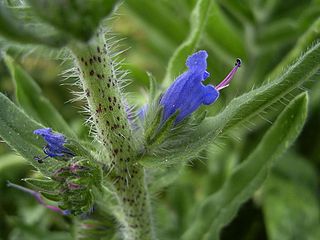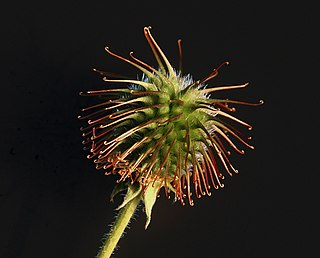
Goosegrass is a common name for several grasses, sedges, and annual herbs. The origin of the name is due either to a plant's use as food for geese or plant parts that look like the foot of a goose.

In biology, an indumentum is a covering of trichomes on a plant or of bristles of an insect.

Eriophyidae is a family of more than 200 genera of mites, which live as plant parasites, commonly causing galls or other damage to the plant tissues and hence known as gall mites. About 3,600 species have been described, but this is probably less than 10% of the actual number existing in this poorly researched family. They are microscopic mites and are yellow to pinkish white to purplish in color. The mites are worm like, and have only two pairs of legs. Their primary method of population spread is by wind. They affect a wide range of plants, and several are major pest species causing substantial economic damage to crops. Some species, however, are used as biological agents to control weeds and invasive plant species.

A bur is a seed or dry fruit or infructescence that has hooks or teeth. The main function of the bur is to spread the seeds of the bur plant, often through epizoochory. The hooks of the bur are used to catch on to for example fur or fabric, so that the bur, which contain seeds, then can be transported along with the thing it attached itself to. Another use for the spines and hooks are physical protection against herbivores. Their ability to stick to animals and fabrics has shaped their reputation as bothersome.
NVC community SD3 is one of two strandline community in the British National Vegetation Classification system.

Galium boreale or northern bedstraw is a perennial plant species of the Rubiaceae family. It is widespread over the temperate and subarctic regions of Europe, Asia and North America including most of Canada and the northern United States.

Galium saxatile or heath bedstraw is a plant species of the genus Galium. It is related to cleavers.

Galium spurium, the stickwilly or false cleavers, is a plant species of the Rubiaceae. It is widespread across Europe, Asia, Africa and Canada, and is naturalized in Australia. It is considered a noxious weed in many places.

Stickyweed may refer to several plant species including:

Galium tricornutum is a species of flowering plant in the coffee family known by the common names rough corn bedstraw, roughfruit corn bedstraw, and corn cleavers. It is widespread across most of Europe plus northern Africa and southern Asia, from Norway, Portugal and Morocco to China. It is also naturalized in Australia, the Canary Islands, Mauritius, Madeira, Réunion, Brazil, Argentina, and scattered locales in North America.

Galium aparine, with common names including cleavers, clivers, catchweed and sticky willy among others, is an annual, herbaceous plant of the family Rubiaceae.
British NVC community OV13 is one of the open habitat communities in the British National Vegetation Classification system. It is one of eight arable weed and wasteland communities of fertile loams and clays.
British NVC community OV24 is one of the open habitat communities in the British National Vegetation Classification system. It is one of four tall-herb weed communities.

Cecidophyes is a genus of mites in the family Eriophyidae. It is a plant parasite, causing galls or other damage to the plant tissues.
Poleá or "pulley" is a typical recipe of Andalusian cuisine, particularly the provinces of Seville, Huelva, and Cádiz. It is a variant of porridge typical of those consumed in hard times. The dish is made with water, flour, salt, anise, milk, and sugar. Other ingredients are sometimes added. It is usually served with croutons of fried bread.

Galium verrucosum, common name warty bedstraw (US) or southern cleavers (UK), is a species of plants in the Rubiaceae. The epithet "verrucosum" means "warty" in reference to the numerous bumps on the mature fruit. It is native to the Mediterranean Basin from Portugal and Morocco to Turkey and Palestine. It is reportedly naturalized in Great Britain, Central Europe, the Canary Islands, Madeira, and Wayne County (Michigan).
Goosetongue is a common name for several plants and may refer to:

Lodge Wood and Sandford Mill is a 2.3-hectare (5.7-acre) biological Site of Special Scientific Interest east of Woodley in Berkshire.













